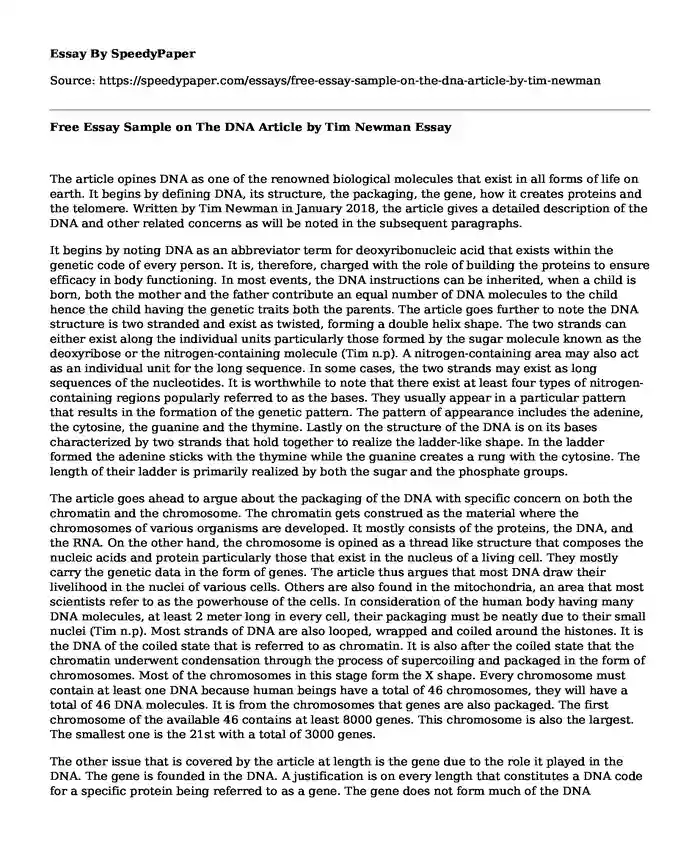The article opines DNA as one of the renowned biological molecules that exist in all forms of life on earth. It begins by defining DNA, its structure, the packaging, the gene, how it creates proteins and the telomere. Written by Tim Newman in January 2018, the article gives a detailed description of the DNA and other related concerns as will be noted in the subsequent paragraphs.
It begins by noting DNA as an abbreviator term for deoxyribonucleic acid that exists within the genetic code of every person. It is, therefore, charged with the role of building the proteins to ensure efficacy in body functioning. In most events, the DNA instructions can be inherited, when a child is born, both the mother and the father contribute an equal number of DNA molecules to the child hence the child having the genetic traits both the parents. The article goes further to note the DNA structure is two stranded and exist as twisted, forming a double helix shape. The two strands can either exist along the individual units particularly those formed by the sugar molecule known as the deoxyribose or the nitrogen-containing molecule (Tim n.p). A nitrogen-containing area may also act as an individual unit for the long sequence. In some cases, the two strands may exist as long sequences of the nucleotides. It is worthwhile to note that there exist at least four types of nitrogen-containing regions popularly referred to as the bases. They usually appear in a particular pattern that results in the formation of the genetic pattern. The pattern of appearance includes the adenine, the cytosine, the guanine and the thymine. Lastly on the structure of the DNA is on its bases characterized by two strands that hold together to realize the ladder-like shape. In the ladder formed the adenine sticks with the thymine while the guanine creates a rung with the cytosine. The length of their ladder is primarily realized by both the sugar and the phosphate groups.
The article goes ahead to argue about the packaging of the DNA with specific concern on both the chromatin and the chromosome. The chromatin gets construed as the material where the chromosomes of various organisms are developed. It mostly consists of the proteins, the DNA, and the RNA. On the other hand, the chromosome is opined as a thread like structure that composes the nucleic acids and protein particularly those that exist in the nucleus of a living cell. They mostly carry the genetic data in the form of genes. The article thus argues that most DNA draw their livelihood in the nuclei of various cells. Others are also found in the mitochondria, an area that most scientists refer to as the powerhouse of the cells. In consideration of the human body having many DNA molecules, at least 2 meter long in every cell, their packaging must be neatly due to their small nuclei (Tim n.p). Most strands of DNA are also looped, wrapped and coiled around the histones. It is the DNA of the coiled state that is referred to as chromatin. It is also after the coiled state that the chromatin underwent condensation through the process of supercoiling and packaged in the form of chromosomes. Most of the chromosomes in this stage form the X shape. Every chromosome must contain at least one DNA because human beings have a total of 46 chromosomes, they will have a total of 46 DNA molecules. It is from the chromosomes that genes are also packaged. The first chromosome of the available 46 contains at least 8000 genes. This chromosome is also the largest. The smallest one is the 21st with a total of 3000 genes.
The other issue that is covered by the article at length is the gene due to the role it played in the DNA. The gene is founded in the DNA. A justification is on every length that constitutes a DNA code for a specific protein being referred to as a gene. The gene does not form much of the DNA molecule. It is about 3 percent while the remaining 97 percent are made up of other substances. Some of the renowned DNA molecules are believed to be those that take part in the transcription and translation regulations. It is also significant to realize that the creation of proteins by the DNA molecules involves the two regulatory processes (transcription and translation). Finally, the author of the article ends by arguing about telomere as the regions that occur continuously and are composed of the chromosomes at the end of the nucleotides (Tim n.p).
In consideration of the author's view about the DNA, I believe the article competently addressed the meaning of DNA, its structure, how it is packaged and the formation of proteins coupled with a view of the gene. The definition appeared simpler and can be easily understood by a learner of any grade. The article also enlightened me on the difference between the chromatin and the chromosome. The two may be confusing at times since they follow each other going by their functionalities. The article can, therefore, be used in scientific research analysis on matters about the DNA.
Works Cited
Tim, Newman. What is DNA and How does it Work. MNT Home. 2018. Print. Retrieved from https://www.medicalnewstoday.com/articles/319818.php
Cite this page
Free Essay Sample on The DNA Article by Tim Newman. (2022, Jun 07). Retrieved from https://speedypaper.net/essays/free-essay-sample-on-the-dna-article-by-tim-newman
Request Removal
If you are the original author of this essay and no longer wish to have it published on the SpeedyPaper website, please click below to request its removal:
- Essay Example on Enterprise Risk Management at Wells Fargo
- Free Essay on Theodore Roosevelt's Character Traits that Helped Him Become Successful
- Saving Private Ryan - Movie Research Essay Example
- Free Essay Sample on Marijuana and Canadian Workplace
- Free Essay about Smart Metering Solutions
- Paper Example on Critical Appraisal of Planning
- Paper Example on Role of HR in Marketing
Popular categories





